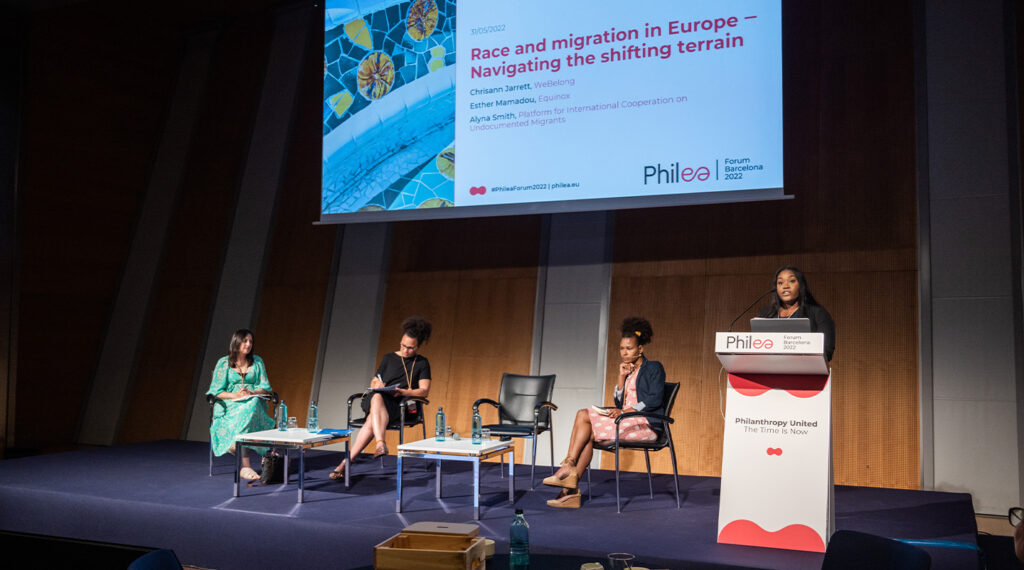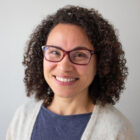Navigating the shifting terrain of race and migration in Europe

Philea’s Biray Bensu De Meulemeester dives into one of the sessions from the Philea Forum 2022, “Race and migration in Europe ‒ Navigating the shifting terrain”, by interviewing three of the speakers involved: Chrisann Jarrett, WeBelong; Esther Mamadou, Equinox; and Alyna Smith, Platform for International Cooperation on Undocumented Migrants.
Biray Bensu: Alyna, at the Philea Forum you touched on the narrative of threat and how a securitisation frame is hiding the racial aspect of migration issues. How do you see new technologies playing a role in this and what can philanthropic organisations do to address this challenge?
Alyna: Indeed, the conflation of securitisation with migration, and the fact that we see policies driven by narratives of threat, have led us to see the strengthening of punitive approaches – from the increasing use of invasive technologies at borders, to increased surveillance and the large-scale processing of people’s data. And one of the challenges around this is how hidden it often is.
In this context, what philanthropy can do is support the efforts of civil society to bring about accountability, which has multiple dimensions:
- Accountability is exposing the truth and understanding what is happening.
- Accountability is engaging with affected individuals and communities, investing in efforts to understand their experiences, what they would like to see in terms of change and how they can be implicated in that.
- Accountability is also supporting initiatives and efforts to empower people affected by this […] whether that’s locally, nationally or at the European level.
The philanthropy sector should support intersectional work on this. Often this work depends on taking into account multiple perspectives and working at the intersection of migrant rights, racial justice, digital rights and other human rights spaces. Developing those relationships and shared strategies takes time and resources. That is why it is so important to provide flexible support to allow those coalitions to be built and to bear fruit.
Biray Bensu: Chrisann, you suggested funders apply systems change to their operations. How do you see philanthropic organisations tackling this and what is the role of lived experience in this?
Chrisann: I see the role of philanthropists in the space of systems change as active participants in society in general. We should try and stay away from philanthropy – or trusts and foundations – simply giving money to organisations or grass-roots groups, thinking that they should solve all the problems by themselves.
Because obviously, there’s an imbalance of power between those communities and the people actually giving that money. To redress that, there needs to be a genuine internal conversation within trusts and foundations before they give out any money, asking themselves why are they doing this work and what sort of society do they want to reimagine together .
To achieve systems change, it’s also important for trusts and foundations to put egos aside. Likewise, for organisations and stakeholders working in this field, the issue isn’t about you, it’s about us. It’s a collective effort. And that narrative should also be collective. It’s not about who’s securing the win, it’s how we secure the win.
Systems change is about understanding that systemic reform happens over a sustained period of time with the assistance of financial resources alongside non-financial methods or resources. The latter could include, for example, the sharing of experience by funders with a bird’s eye view of a sector or a specific space. Bringing together actors and recognising how we work across each organisation or society could be beneficial to the movement as a whole.
Finally, understanding trends is very important to tackling systems change. This can be done through that bird’s eye view, for example, that trusts and foundations have from having funded so many different movements or organisations. They have a strong evidence base of what works and what doesn’t. So how are they using that insight and that knowledge to also benefit the field? That’s a question that needs to be asked.
On the role of lived experiences, I would say that historically speaking, a lot of civil rights movements have been led by people impacted directly. But within the migration space and within the trust and foundation space, we see lived experience almost as a novelty when actually it’s been around for a very long time. But with migration, people always see individuals through the lens of victimhood and vulnerability as opposed to taking an asset-based approach and supporting lived-experience activism. It’s all about assets.
It’s understanding that alongside practical and learned experience, lived experiences also need to be elevated to say this is of equal importance for the transformative reform of the society that we live in. So understanding that lived experience is at the core, that it is essential for social justice, and taking an intentional approach to engaging in communities, really understanding what they need and those communities directing the movement, are all key. Lived experience activism shouldn’t be tokenised either. It shouldn’t be based on or reduced to case studies. It’s about the meaningful engagement of those actively being suppressed or oppressed by a system. So that’s what my intervention would be.
Biray Bensu: Esther, you have touched upon the unequal treatment of people fleeing wars, especially within Europe, considering the current war in Ukraine. What needs to be done to address this and what is the role of philanthropy regarding this unequal treatment towards refugees?
Esther: The TPD (Temporary Protection Directive) is a specific mechanism in refugee and international protection, which goes along with the rest of the mechanisms of international protection. The TPD is a mechanism that was designed to be quicker, more efficient, give a better response, calling on different countries around Europe or civil society stakeholders to basically give a response to a situation of emergency and mass influx.
The TPD was designed within human rights law and refugee law to give a better response to a crisis. So what needs to be done is to apply the TPD as it is, with the human rights approach that it was designed with. This means additional guarantees of other human rights mechanisms and instruments are not necessary.
And it needs to be applied as any international protection mechanism without any kind of discrimination on the grounds of ethnicity, race or legal status. Discrimination in the application of such a mechanism is contradictory – people apply for asylum because of just these kinds of discrimination. It’s also unethical and goes against the Geneva Convention.
So we can’t accept any kind of discrimination. And that means we have to denounce it. So from a philanthropy perspective, these organisations need to denounce this kind of discrimination. This is only right for organisations that ask for accountability at European Union level, for organisations that allow for accountability at national level, and for organisations that are pushing for changes in migration and refugee protection policies that help us move away from a security-based approach to a human rights approach.
Biray Bensu: What needs to be done to address this and what is the role of philanthropy?
Esther: We need to get funding from organisations that really reject discrimination within an application process that is designed to protect and to welcome in a very comprehensive, fast, efficient, and inclusive way.
Biray Bensu: Considering that this year is the European Year of Youth, if more young people were a part of decision-making around policies and programmes that impact their own lives, what would be different?
Alyna: Coming back to the theme of lived experience, young people can bring the very important perspectives of youth, which are not necessarily the same as the perspectives of those in positions of power and decision-making. And in the case of undocumented youth, what we actually see is that in some contexts they have had the experience of protection, they’ve had the experience of having full rights as children, and then they’ve had the experience of aging out of those rights. They’ve had the experiences of transitioning out of a space of protection as children into a youth of uncertainty and precarity. So they can share the perspective of what it means to live, both where you have a feeling and an understanding of what it means to be recognised as a full member of society, and how something like your administrative status can change so much overnight. They can convey the importance of recognising how policies, laws can have a profound impact on a person’s experience from day to day.
Also, they can bring the energy and perspective of people who can see maybe a different future and can imagine things in ways that those of us stuck in our ways maybe have a harder time with. So I think it can only be positive to have more spaces, to bring youth to the table, to share their perspectives and their experiences, their insights. Being a young person doesn’t mean that you can’t have a depth of experience and insight. And I think we need to recognise the very important and valuable perspective, expertise even, that young people can bring.
Esther: I wanted to add that in terms of human rights violations, the right to education and the rights to migration – that is international protection and the right to have housing – those violations of rights in young populations have a really deep impact that can pave the way for the rest of their lives. I’m talking about how important it is to be able to cross borders when you’re fleeing a conflict and access the country of refuge that you want, and to get access to education with no discrimination. Also if we’re talking about imagining a different system, as long as we are kept in this system we won’t really end racism because it’s something structural. If we want to dismantle racism, we need to imagine a different world. The best way to do this is to take into account the experiences, the perspective of youth.
So I think it’s better to train youth to imagine a different system, a different future, different ways of functioning, than to rely on changing the minds of people who are resistant to change.
Chrisann: I am a young person, and I work with young people. We’ve benefited so much from intergenerational approaches to change-making. I’m not sure if this is unique to the UK context, but the field of youth-led change-making and activism is seen as so distinct from the rest of the fields of youth and activism. And that’s really problematic because that implies that young people are leaders in waiting, as opposed to leaders now. The issues that we’re facing, whether it be migration or the intersectional kind of cross-cutting issues, are really urgent and they need everyone’s attention right now.
There is a zeal in this generation of young people who are so emboldened to question in a way that the older generation isn’t. And there’s a certain level of discomfort when it comes to anything that resembles injustice. And I think that we could vibe off of that as a movement, as a whole and as a society. Intergenerational approaches to policymaking are just so much better. Young people have a lot to say – they just need a vehicle and a platform to say it.
So I think moving forward, what would be so great to see is young people also in philanthropy within inclusive frameworks. So for example, at this conference, it would be nice to have an integrated approach to these discussions – with young people kind of spread through the whole thing as opposed to them having subsections where they discuss their issues. Everyone needs to hear from young people. So this is about a more inclusive framework around governance, change-making, who gets to be at the decision-making table and recognising that young people are here right now and they need to be equipped. For systems change you need everyone’s voice.
And the final thing I would say is that that role of older, more established organisations incubating young people is key. Young people have great ideas that they want to test and try out, but they might not actually be so interested in applying for funding, which they might find too tedious to bother with. They just want to do the work. So there’s a role for everyone to play where an older, more established organisation could provide the infrastructure around change-making so the young people can focus on the doing.
Esther: On the topic of movements, I don’t know if you’re aware of the context of Colombia. Last year there was this national strike that pushed the government to stop tax reform. It was young people that led this national strike for three months, and they received a heavy, violent response from law enforcement with recorded killings, disappearances and executions. And now this is having consequences in terms of what they have been pushing for. Colombia is one of the countries with the largest Afro populations in Latin America, and in May Colombia elected its first black woman as vice-president. So this is a real example of how young people can really provoke a drastic change in society, maybe not a structural change, but really a power dynamic change that is meaningful and impactful.
The elected vice-president is not only a black woman, she is an activist and a land-rights defender. As vice-president, that is going to make a shift in Colombian history forever, after 52 years of internal conflict.
Authors



